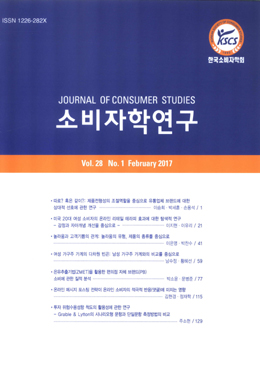개인의 투자의사결정에서 가장 중요한 요인은 본인의 투자성향을 파악하는 것이다. 본 연구는 투자위험과 관련한 개인의 심리적인 성향을 파악하기 위해 활용되는 투자위험수용성향 측정도구의 활용가능성을 탐색하고자 하였다. 시나리오형 질문으로 구성되어 있는 Grable & Lytton(1999, 2003)의 13개 문항을 한국어로 번역하여 서울 및 수도권에 거주하는 40대 남녀 806명을 대상으로 투자위험수용성향을 조사·분석하였고 이를 국내 금융사에서 많이 사용하고 있는 투자유형선택 단일문항의 응답과 비교하였다. 특히, 응답자의 투자행태를 상품이 가지고 있는 위험의 정도에 따라 분류하여 주관적으로 응답한 투자위험수용성향이 실제 투자행태에 반영되는 지를 살펴보았다. 분석결과 두 가지 유형의 투자위험수용성향 척도는 서로 의미 있는 상관관계를 보였으며 다수의 응답자가 동일한 응답을 하였으나 완전히 일치하는 것은 아니었다. 두 가지 유형의 투자위험수용성향 척도로 측정한 개인의 투자위험수용성향은 선행연구에서 밝혀진 관련 변수 중에서 성별, 재무지식, 재정만족도와 동일한 관계를 보였다. 두 가지 척도는 모두 응답자의 위험자산투자행동(주식이상 투자)에 영향을 미치는 변수로 나타났다. 투자행태에 대한 분석을 통해, 우리나라에서 많이 사용되고 있는 단일문항은 개인의 투자유형을 측정하는 항목으로 개인의 심리적인 성향을 측정하는 데에는 다소 미흡할 수 있으나 개인의 투자행태를 구분하는 데에는 유용한 도구가 될 수 있음을 알 수 있었으며, Grable & Lytton의 13개 문항은 개인의 성향을 측정한다는 측면에서 단일문항을 보완하는 도구가 될 수 있음을 알 수 있었다. 따라서 투자위험수용성향을 측정함에 있어서 다양한 문항을 검토·종합하여 사용할 것을 제안하며, 향후 지속적으로 금융소비자의 투자위험수용성향을 파악하는 다양한 방법에 대한 연구가 필요할 것으로 보인다.
The most important factor that influences individual investment behavior is the investment risk. The uncertainty of investment risk can influence individual investor`s financial well-being in a great degree, therefore suitability is a very important rule. To identify suitability, it is recommended to estimate individual investor`s investment profile. Individual investor`s investment profile is consisted with investment knowledge and experience, risk or investment capacity, and risk attitudes. The risk attitudes of the investment profile is personal trait that is relatively stable over time and it is called `financial risk tolerance.` This study tried to explore the usefulness of two different financial risk tolerance measurements: single item measurement that identifies individual`s investment type and a 13-item measurement developed by Grable & Lytton (1999, 2003). A survey with 806 individuals on their 40s were conducted to examine their financial risk tolerance and investment behaviors. According to the analyses, it has been found that the degree of Korean adults` financial risk tolerance is not high. The outcomes of the two financial risk tolerance were significantly correlated each other. Korean adults` financial risk tolerance that were measured with the two measurements was related with gender, financial knowledge, and financial satisfaction. Individuals` investment behavior can be predicted with financial risk tolerance and the two measurements can properly estimate individual`s attitudes toward financial risk. While the single item could be used to predict individual`s investment type, the 13-item measurement could be used to measure individual`s psychological traits. Further research on identifying financial risk tolerance is necessary.




